Who is your favorite guitarist? Stupid question right? The answer has got to be two names: Dave Murray and Adrian Smith. With this chapter in our study of Maiden History we celebrate the guitar playing of Iron Maiden‘s classic era and discuss the band’s conquest of America in the mid-1980s.
1982 and 1983 saw the coming to Maiden of singer Bruce Dickinson and drummer Nicko McBrain, momentous occasions in Maiden history:
Dawn of the Classic Era, 1982-83.
By the release of Piece Of Mind in 1983 the band had found their classic line-up. That year they even did a first, and very successful, headlining tour of North America. And if anyone expected Maiden to run out of steam at that point, they were dead wrong.
The band went on to release Powerslave (1984) and Live After Death (1985) in quick succession, the joint pinnacle of Iron Maiden’s classic era. These records are marked by the consolidation of one of hard rock and metal’s most iconic guitar partnerships: Dave Murray and Adrian Smith, the axe team that really made the 1980s rock.

Adrian Smith and Dave Murray, making the 80s glove…glow…rock!
TWINS
Dave Murray was always Steve Harris’ first choice as lead guitarist, ever since the Maiden chief first heard him play. Whatever happened – Murray as the only guitarist, Murray partnered with one or even two others, Murray being fired from the band by singer Dennis Wilcock – Harris knew he wanted the blond guitarist in his band. Period.
In the end the bassist started building Iron Maiden around Murray and drummer Doug Sampson, before getting singer Paul Di’Anno in and establishing what we know these days as the early Iron Maiden sound.
But Maiden were always about twin guitars. It was one of the founding principles of Harris’ new band, to craft a sound inspired by the twin leads and harmonies of bands like Wishbone Ash and Thin Lizzy.
“The plan was always to get a second guitarist in, but finding one that could match Davey was just really difficult.”
Steve Harris
A host of short-lived Maiden line-ups followed, as the band searched for a second guitar player. As they got closer to recording their first album in late 1979, it became important to get the position filled. At this point, the inevitable happened: They asked Adrian Smith to join.

Old friends Smith and Murray were destined to be in a big band together, even if Smith turned down the initial offer from Iron Maiden in late 1979. Here they are on the World Piece Tour in 1983.
At that time Smith was putting all his efforts into his own band, Urchin, who had a minor record deal and looked like they could be about to make it. But the guitarist was tempted, both because Maiden were signing a major record deal with EMI, and because he was a childhood friend of Murray’s. Smith later admitted the temptation, telling Maiden biographer Mick Wall that, “I smoked my way through two packs of cigarettes thinking about that one.”
He eventually declined, telling Harris that, “I was happy singing, playing and writing our own stuff.” Harris understood perfectly. “I suppose it was a bit like me with Maiden,” said the bassist. “It was his band, and he rightly wanted to stick with it and see if he could make it happen.”
So Smith did not join, becoming the only person to refuse a Maiden offer after they got their EMI record deal, but Harris’ respect for him grew. However, Urchin fell apart soon after, while Maiden got Dennis Stratton in the band for their debut album Iron Maiden (1980).
It looked like Smith had missed the boat…
FATE
Without a band, and without a job, Smith ventured into the West End of London, trying to sell “demos of some new songs I had written. I was down on my luck at this point.” His excursion into the west did not go well, and Smith felt even worse about things. Depression was setting in.
“I remember walking home because I had no money for the bus and feeling really down about everything. I think it was probably raining too – you know, the whole depressive cliché.”
Adrian Smith
Walking home while lost in his own thoughts, Smith bumped into Harris and Murray in Clapton High Road. “It was like fate!” Smith would later say. At that point Maiden had just returned from their European tour with KISS and were about to fire Dennis Stratton. The Maiden pair asked how Adrian was doing, and he told them that Urchin was inactive. Smith would recall the encounter in his memoir:
“I noticed as I was talking that Steve was looking at me very intently, and even Mr. Murray’s trademark grin had been replaced with an expression bordering on seriousness. […] There was a momentary gap in the conversation and the three of us stood there on the pavement, a stone’s throw away from where Dave and I had grown up and taken our first faltering steps on the rock ‘n’ roll ladder. […] Steve broke the silence. ‘We might be needing a guitarist,’ he paused, ‘If we call again, will you do it?’ “
Adrian Smith
After turning Maiden down the year before, the lack of money for a bus ticket had now led to another shot at seizing the opportunity of a lifetime. Steve Harris was offering him a second chance. “This was no polite enquiry on his part,” Smith says. “More like, this is your last chance.”
“I got the message,” Adrian remembers.
Click here to read more about how and why members have left Iron Maiden through the ages!
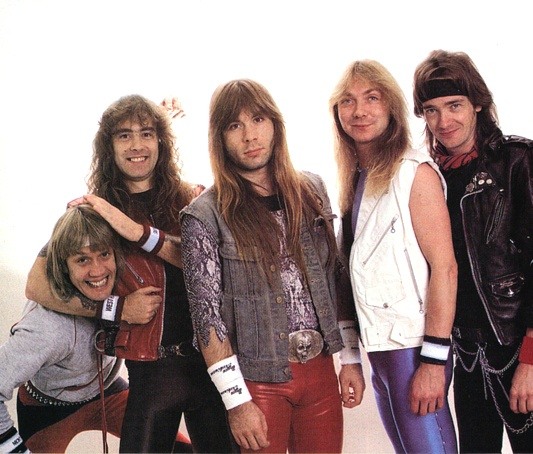
Fate turns Adrian Smith’s life around, and he finally teams up with his ultimate guitar companion, Dave Murray. By 1984, Maiden’s classic line-up would be well established, l-r: Nicko McBrain, Steve Harris, Bruce Dickinson, Murray and Smith.
Smith was asked to audition for Maiden in London in late 1980, a request that surprised him a little since he thought Murray knew more about his guitar playing than Smith did himself.
The audition went well and everyone got along great. Manager Rod Smallwood was apprehensive though, probably because Smith had already turned Maiden down once, and he kept interrogating the guitarist to make sure he could play both riffs and leads. Harris would tell Smallwood to ease off, “which set the pattern for the next few years”, Smith remembers, “Rod putting the pressure on and Steve deciding when enough was enough.” Smith went to a nearby pub with the tour manager to wait for the band’s decision.
“To be honest, I wasn’t quite sure what a tour manager was, but he took me to the pub and bought me a drink and I thought, ‘Yeah, tour managers are OK.’ “
Adrian Smith
The message soon got back: Smith was in. And Iron Maiden went to work on their second album, Killers (1981), which saw the beginning of the Murray/Smith partnership that would not only be essential to Maiden’s development, but extremely influential to the sound of heavy metal throughout the 1980s and beyond.


Adrian Smith (rocking out, top, and eating out, bottom) was instantly well-liked by the others in the band and would very soon become a major songwriting force for Iron Maiden. What didn’t show on the outside was that he felt an accute lack of confidence in his own guitar skills. (Photos by Keith Wilfort, published by Loopyworld.)
Iron Maiden fans today might be surprised to learn that the new guitarist was not at all sure of himself and his ability to help Maiden climb the ladder. Smith was worried that someone at any moment would turn around and expose his lack of prowess as a lead guitar player.
“I did compare myself to other players technically when I was younger – and not very favourably. I grew up playing and singing, so I was always more of a second guitarist. I usually had a virtuoso to lean on. Then all of a sudden every band we played with seemed to have a virtuoso who’d learned from Eddie Van Halen, and that bothered me. I was very insecure about that.”
Adrian Smith
In fact, as Smith pointed out to Mick Wall many years later, “My first serious project was Iron Maiden. Before that, I was always in my own band.” When in control of his own band Adrian had felt secure, but as one half of the Maiden guitar team he was much less self-assured.
Despite his worries, the Maiden fans took to the new guitarist quite quickly, he seemed to fit the band well, and Smith would soon find himself on the first step of a plan for Iron Maiden to conquer the all-important market of the United States of America.
MASTERPLAN
The classic Iron Maiden sound was actually created as early as Killers, in no small part thanks to producer Martin Birch and the welcome addition of Adrian Smith to the line-up. In the following years Maiden grew into their classic era proper, with the release of The Number Of The Beast (1982) and Piece Of Mind (1983). The Murray/Smith partnership blossomed as Maiden traveled the world and recorded one metal masterpiece after the other.
“I can’t imagine ever having that two-way mental thing going like that with any other guitarist.”
Adrian Smith
Smith would not only be one half of the Maiden guitar team, he would also emerge as one of the three most important songwriters in the band. Harris’ metal anthems and epics would always be the backbone of the Maiden records, but singer Bruce Dickinson quickly joined in the fun with proggy adventures like Revelations and Powerslave.
With Murray rarely writing, and drummer Nicko McBrain not writing at all, Smith became the “other voice”, churning out more accessible rockers like The Prisoner, Flight Of Icarus, and 2 Minutes To Midnight, co-writing with either Harris or Dickinson.

In early 1983, 1984 and 1986 Iron Maiden would write their new music in Jersey, the Channel Islands, before heading to the much warmer climate of Nassau in the Bahamas to record. Photographer Ross Halfin would often come along to capture moments.
By January 1983, as the new line-up of Iron Maiden were writing Piece Of Mind on the cold and stormy island of Jersey in the English Channel, Smith’s writing partnership with Dickinson came into full bloom. While Harris preferred to work out his songs on his own before bringing them to the others, Smith and Dickinson started to throw ideas around in a much looser fashion, as the singer would recall in his autobiography:
“Flight Of Icarus began life in a toilet. Adrian was fond of playing guitar in bathrooms – he liked the ambience from the tiles – and, while he was noodling away, I heard a sequence of chords and started singing along to them. The chorus of Flight Of Icarus started flying like an eagle as a result.”
Bruce Dickinson

From toilets to touring. Iron Maiden bring World Piece in 1983.
Flight Of Icarus is the only Iron Maiden single ever to get any significant airplay in the US, a fact which helped lift it to number 8 in the Billboard singles chart. Although Maiden never aimed at radio success, it is clear that getting big in the North American market was a goal from the beginning. To this end manager Rod Smallwood devised a five-year plan with Maiden’s US label Capitol Records.
Smallwood had already toured America on Maiden’s behalf in 1980, meeting with record company executives and regional personel across the States to hype this great new band he had discovered in England, while said band was touring Europe as support for KISS. Smallwood had originally toyed with the idea of getting experienced American managers to handle Maiden in the States, but was told by his friend and Zomba Music Publishing co-founder Clive Calder that, “When you talk about Maiden you’ve got passion in your eyes. Go see the American label and convince them.”
Two of the many friends Rod made on his passion tour were Bruce Ravid, who worked in talent scouting and artist development at Capitol, and label president Don Zimmermann himself. Once Zimmermann and Ravid were both smitten with Smallwood’s enthusiasm for Iron Maiden, the three of them constructed a plan to relentlessly work Maiden towards the top in the period from 1980 to 1985.

The man with the plan. Rod Smallwood in the 1980s.
The plan involved a dizzying work schedule for the band: One album release every year, and one world tour every year that included a massive American leg. With the aid of merchandise and marketing created around their grotesque Eddie mascot, the theory was that a hardworking Maiden could build their US popularity year by year and reign supreme by 1985.
Rod took the plan to Capitol’s regional offices around the States and charmed people into believing in the cause. Joel McFadden was branch manager in Minneapolis and remembers that Smallwood rolled right over people in the best possible way: “You felt like you’d do anything for him and the band. Long before Maiden set foot here, there were thousands of people who wanted to be part of breaking them in America.”

World Piece Tour 1983. This was Iron Maiden’s first headlining tour of North America, a gamble that paid off. Eddie would always be a team player too.
Once Smith had joined the band, Killers was released in early 1981 and Maiden spent two summer months that year supporting Judas Priest in the US, building a reputation for not letting the audience ignore them.
In 1982, after hiring Bruce Dickinson, Maiden released The Number Of The Beast early in the year and spent most of the subsequent tour in North America, supporting Priest again as well as Rainbow, .38 Special and Scorpions. As 1983 dawned and Maiden got ready for Piece Of Mind, Smallwood and Capitol decided to move Maiden into headlining.
“In terms of statistics we weren’t really a headlining band, but we just went for it. I remember the sales figures coming in for our Seattle date and we’d sold out. A few weeks later we sold out Madison Square Garden for the first time, and we knew we’d pulled it off.”
Rod Smallwood
It was a major turning point in Maiden’s career to tour America as headliners on the World Piece Tour. As Smith later recalled, “They said we weren’t ready for it, and that we’d never be able to pull it off, so I think we wanted to show them. We had something to prove.” Indeed, according to the five-year masterplan it was time for Maiden to step up. It would make them or break them.
The 1983 tour was a resounding success. Maiden spent four months headlining in North America and laid the groundwork for what was to come. Now the next album project was vitally important.
POWERPLAY
Putting Powerslave (1984) on even today, one is struck by the guitar work on display: From the harmony guitars that open Aces High, through the delicate and groovy riffing of The Duellists, to the otherwordly chords and solos of the title track’s middle section, this is guitar playing to reference. Without the pairing of Murray and Smith, it’s doubtful if Iron Maiden would have become such a powerful force.
Click here for our review of Powerslave!
Smith contributes two songs to the album, first single 2 Minutes To Midnight and the less appreciated Back In The Village, both written with Dickinson. Murray on the other hand doesn’t contribute a single song, keeping up his average of one song every other album. But credits aside, it’s the flawless guitar work that truly steals the show on the Powerslave album.

The Moshe Brakha photo for the inner sleeve of the Powerslave album has a serious mystique about it. Murray and Smith, flanking the others, would provide the audio counterpart through their guitar work on the album.
Recording at Compass Point in the Bahamas, Maiden were once again produced by the great Martin Birch, who had no small amount of guitar experience from his work with bands like Deep Purple and Black Sabbath.
The album’s sound is very heavily guitar-oriented, and the band indulges in sophisticated guitar overdubs that still don’t distract from the live aesthetic that had become so important to Maiden. The sound of Powerslave is the sound of a band who is completely at ease with their own style and direction.
“Piece Of Mind had given us a new confidence, and a desire to break out of the ‘angry East End punk metal’ identity that we had been saddled with by the media, and which we never were.”
Bruce Dickinson
Harris would agree with this, later stating that, “We had done a world tour to bed Nicko into the band. Obviously the bass player has to work very well with the drummer. So yeah, maybe it did create some more confidence.” And one of the clearest signs of Maiden’s self-confident stride into territory all their own is the guitar playing of Murray and Smith.
There are three-part harmonies audible on tracks like Aces High, The Duellists, and Dickinson’s awesome Powerslave. The latter song was made up of two separate ideas, the Egyptian gallop of verse and chorus on the one hand and the solo and harmony section on the other, that Harris suggested he glue together. There is also plenty of layered rhythms and harmonies in parts of 2 Minutes To Midnight and the phenomenal 13-minute Rime Of The Ancient Mariner. The latter is a prime example of the guitar duo’s ability to weave soundscapes without riffs, leads or power chords. The eerie middle section transports the listener through space and time as the guitars conjure up images of foggy seas and creaking ships.

Dave Murray and Adrian Smith live on the Powerslave tour, weaving soundscapes to go with everything from WW2 dogfights to Egyptian pyramids and the deathly appearance of ghost ships.
Rime Of The Ancient Mariner would go down in Maiden history as a milestone, a work of drama and complexity that awed even the band themselves, including its author Steve Harris. Decades later, Adrian Smith would remember the Powerslave writing sessions on the stormy island of Jersey, where material was worked up in advance of recording in the much sunnier Bahamas:
“We had this system whereby we’d each come up with our ideas, then work with whomever to fill them out. Like I would often work with Bruce on lyrics to my songs or Davey on harmonies and guitar parts and that. Steve usually works on his ideas alone, and when they’re kind of 90 per cent done he’ll present them to the band. That presentation, if you like, was always at the end of the day in the main communal area, like a ‘show and tell’ at school! But when he put Mariner forward I just knew we had to do it, because I’d never heard anyone do anything like it before. I think when we recorded it in the Bahamas he had to hang the lyrics from the top of the wall all the way to the floor, there were so many. And Steve was so fired up about it he convinced everyone else.”
Adrian Smith
“I wrote most of it in the Bahamas where we recorded the album,” Harris would remember of the high-pressure creation of his opus. “I had an idea back in Jersey, but really it was at Compass Point Studios where it all came together.” By this point the Maiden chief had access to a band of supreme performers that were primed to imbue his compositions with all the required finesse and dramatics, even turning a last-minute scramble into one of their most massive musical statements.
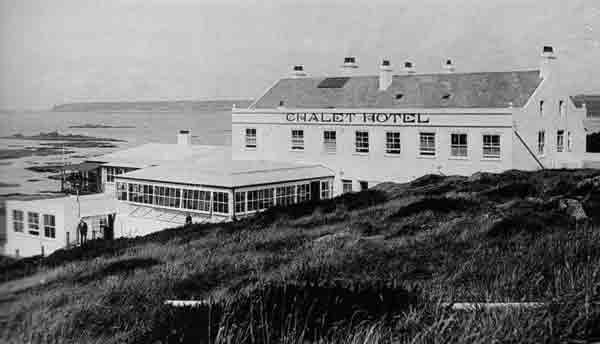
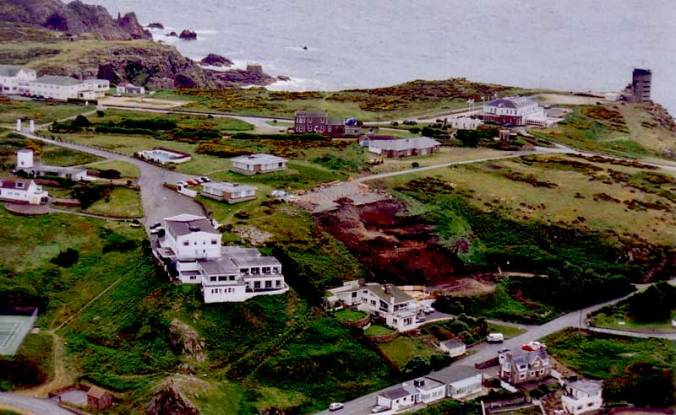
Le Chalet Hotel in Jersey, where Iron Maiden wrote and rehearsed their classic albums Piece Of Mind (1983), Powerslave (1984) and Somewhere In Time (1986). They would then head to the Bahamas to record, where they would also do some frantic last-minute writing, like Rime Of The Ancient Mariner.
Maiden’s guitar work had never before been as sophisticated as it was on the Powerslave record. The band would rely heavily on the guitarists’ atmospheric abilities as well as their flawless lead work when crafting the subseqent Iron Maiden studio album, as this review argues. But the partnership was bearing its ripest fruits at the time of Powerslave. When the band launched their biggest ever tour in 1984, Maiden’s classic era was at its peak, both commercially and artistically.
SLAVERY
There had never been an Iron Maiden stage show as impressive as the Powerslave show that rolled out in the summer of 1984. Derek Riggs’ artwork masterpiece, inspired by the album’s title track, was brought to life with supreme skill and drama:
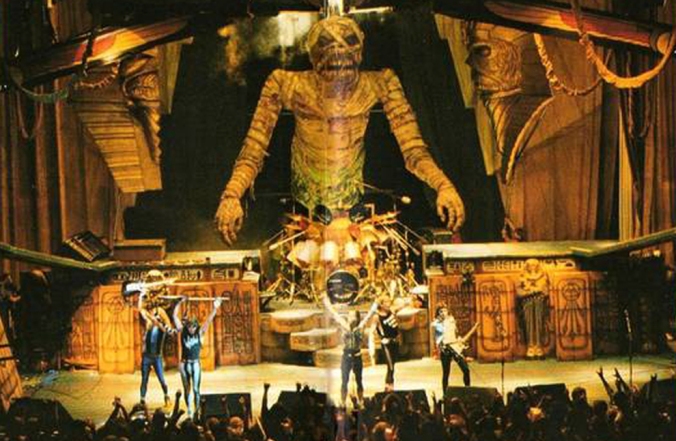
Iron Maiden’s World Slavery Tour awed audiences worldwide in 1984-85.
Maiden Revelations still regards this as one of the very best stage productions the band would ever create, and the band themselves also have the highest regard for it, as their statements to biographer Mick Wall would testify:
“It looked fantastic, and it was probably the best stage show we ever did.”
Steve Harris“I still think that was the best show that Maiden ever put on.”
Bruce Dickinson
Hard not to agree, when watching stuff like this:
Dubbed the World Slavery Tour, Maiden’s global assault started behind the Iron Curtain in Eastern Europe, featuring the full Powerslave stage production. It was a first for any band of their size, and the tour continued through the rest of Europe in August to November 1984.

Eddie goes behind the Iron Curtain with Maiden in 1984.
Then Maiden did their longest ever tour of North America, stretching from November 1984 through March 1985, only interrupted by a trip to Brazil in January for Rock in Rio. April and early May saw visits to Japan and Australia, which were originally intended to be the end of the tour. However, Smallwood celebrated the culmination of his five-year plan by booking another presumably lucrative US leg from late May to early July.
“We should have stopped sooner. It was probably one of many mistakes I’ve made. But, you know, it was really hopping for us then and I was impatient.”
Rod Smallwood
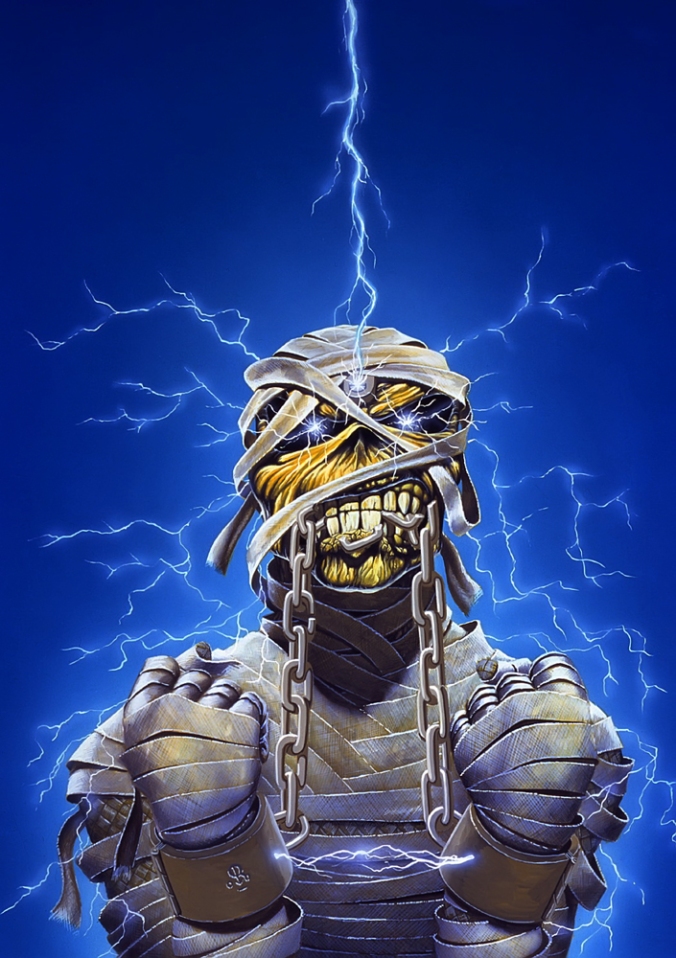
The power of Iron Maiden came close to consuming them on the world tour of 1984-85, ironically mirroring this tour artwork by Derek Riggs.
The North American tour in 1984-85 saw the band diverting to Rio for the one-off festival show as special guests to Queen. After a couple of days of playing and partying in the Brazilian sunshine, it was back to the gloomy winter of Connecticut and Massaschusetts, and very soon a daunting 7 shows at Radio City Music Hall in New York City.
At the fifth Radio City show Dickinson was feeling unwell. Suffering fever and a sore throat, he still struggled through a full set before retiring to bed. Smith hit the town with support band Queensrÿche that night and woke up to a phone call the next day. Tour manager Tony Wigens told him that the next few shows were cancelled as Dickinson was “really sick”, unable to even speak.
“I stayed there in bed for the next three days and nights aching, shivering and sometimes delirious. Most of the band went down sick that week. It had all gotten a bit much.”
Adrian Smith
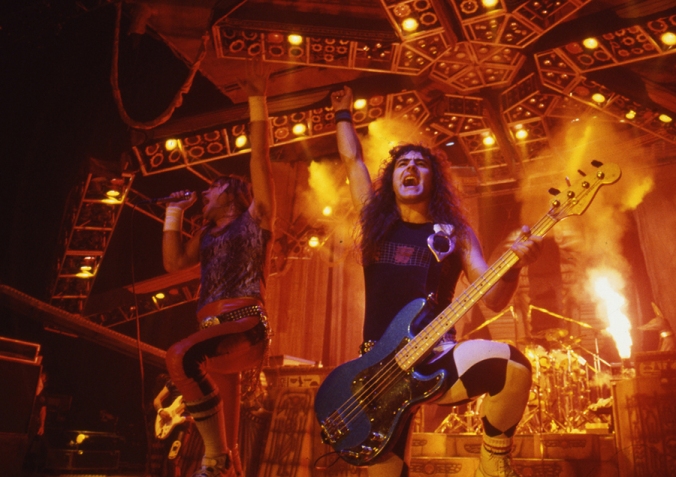
Dickinson and Harris on the punishing World Slavery Tour.
At the end of the trek the band was spent. Dickinson would be the most affected, as time would show. But McBrain remembers his own head swelling with the rise of classic era Maiden, an effect of living in the bubble of non-stop recording and touring year after year, and he recalls how the band eventually shifted to autopilot.
“I’m really surprised we got through that tour. We were at the height of our success, especially in America. We were just in this no-man’s land, and by the end we were all completely burned out. Bruce was almost ready to give up playing and go home. When you get to that stage, it’s just not fun anymore. I mean, it nearly destroyed the band.”
Nicko McBrain
Smith also looks back with a mixture of pride and exhaustion. Maiden had certainly proved themselves, but the World Slavery Tour seemed endless to him, the extensions of the schedule bringing with it inevitable burn-out.
“You’re gone for a year and your whole life goes out the window, basically. By the end, you don’t know how to act properly anymore. You don’t know who you are or what you’re supposed to be doing. I remember I went to see my parents when I got home and I knocked on the wrong door.”
Adrian Smith
Breaking America could have broken Maiden, but it was only the next album project that would bring this to light. For now, in the summer of 1985, it was time for their first real break from touring and recording.
PINNACLE
This time off from activity would still see, well, activity. In 1985 Iron Maiden finally released their first live album. In retrospect, it may seem strange that the band didn’t release the brilliant March 1982 recording of their London show early in the Beast On The Road tour. It was only intended as a video release (which didn’t happen because of lighting issues), but it still sounds awesome nearly 40 years later.
That show was finally made available on CD as part of the Eddie’s Archive box set in 2002, and it showcases the early Murray/Smith partnership impressively:
In 2004 parts of this recording also surfaced on the Early Days DVD set. But back in the classic era, this monster of a performance was not to become the first Iron Maiden live album. It was a different time, when such releases were a very rare occurrence, unlike the nearly-one-live-album-per-tour routine of today.
The 1983 Piece Of Mind tour also passed without an official live document, but with the highly anticipated Powerslave release and world tour, the first time that a line-up of Maiden would go on a second album and tour cycle unchanged, Rod Smallwood realized the time was right. As he would state many years later, tongue-in-cheek: “Your sixth album is a live album. You don’t do one before then.” Then he added the simple truth of the matter: “It all fitted the masterplan.”
Martin Birch was hired to record 4 nights at London’s Hammersmith Odeon in October 1984, and another 4 nights at California’s Long Beach Arena in March 1985. The result was the double Live After Death (1985) album.

Ouch, our eyes! Maiden in 1984, scaring people off with their ludicrous striped shirts and a checkboard-bass.
Performance-wise there are two characteristics about this live document. The first is how singer Dickinson’s voice is starting to deteriorate by 1985 compared to the previous couple of tours, at least partially due to the insane touring schedules.
A lot of vocal overdubs were done in the studio, even if band leader Harris denied this years later, saying, “No overdubs or nothing.” A plain old lie, easy enough to expose if one compares the audio album to the video counterpart where Bruce’s vocals are untouched. Harris would claim that Maiden were still on tour when the live album was mixed and therefore unavailable for overdubs, but Martin Birch’s own liner notes for the album state that he mixed it in July and August of 1985, the weeks immediately following the tour’s end in early July.
Be that as it may, Birch’s studio fixes ensured that the album would become a timeless classic, packaged with yet another glorious Riggs painting:
(Click picture for larger version!)
Click here for our review of Live After Death!
A much more thrilling characteristic of Live After Death is the sound of Murray and Smith. By this point, they have truly become the greatest guitar partnership of the 1980s, maybe of all time. Their interplay is effortless throughout the album. From opening duo Aces High and 2 Minutes To Midnight off the Powerslave album, everything sounds tight and confident. Riffs pulsate, harmonies soar, and leads are traded off like it’s the simple matter of buttering bread.
The sound of Murray’s Fender Stratocasters and Smith’s Gibson Les Pauls, Lados and Ibanezes are captured here for what would become guitar lessons for all eternity. This majestic version of Rime Of The Ancient Mariner, from the Live After Death VHS/DVD, says it all:
The tracklist of the band’s first live record focuses heavily on the three latest studio albums. Indeed, the North American set that makes up the bulk of the record had no songs from Killers and only two from Iron Maiden. Wrathchild and Phantom Of The Opera appear on the album because of their sporadic inclusion in the European setlist.
The five-year plan worked, and in 1985 Iron Maiden could call themselves the biggest heavy metal band in the world. Not that they would, but Rod Smallwood might. His relentless work in building Maiden in America had paid off.

Iron Maiden in 1985: The biggest heavy metal band in the world.
The classic era Iron Maiden were on top of the world. With master bass player Harris leading the charge, the ever-reliable drummer McBrain in the engine room, singer Dickinson fronting them with bravado, and the inimitable guitar duo of Murray and Smith giving them wings.
Their next challenge would be to deal with the fall-out from the World Slavery Tour and protect their new-found status as rock royalty, which you can read all about here:
End of the Classic Era part 1, 1986-87.
Sources: Run To The Hills: The Authorised Biography of Iron Maiden (Mick Wall, [1998] 2001), The History of Iron Maiden, part 1: The Early Days (DVD, 2004), The History of Iron Maiden, part 2: Live After Death (DVD, 2008), What Does This Button Do? (Bruce Dickinson, 2017), Classic Rock Platinum Series and Metal Hammer present “Iron Maiden” (Edited by Dave Everley, 2019), Rock Candy issue 19 (2020), Metal Hammer‘s “Iron Maiden’s Powerslave: The Story Behind the Most Epic Metal Album of the 80s” (Malcolm Dome, 5 August 2020), Monsters of River & Rock: My Life as Iron Maiden’s Compulsive Angler (Adrian Smith, 2020).

